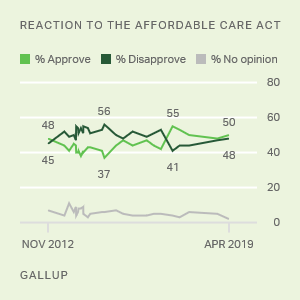Story Highlights
- 34 million adults know someone who died after not getting treatment
- 58 million adults report inability to pay for needed drugs in past year
- Little progress seen by Trump administration in limiting rising drug costs
Editor's Note: The research detailed below was conducted in partnership with West Health, a family of nonprofit and nonpartisan organizations focused on lowering healthcare costs for seniors.
WASHINGTON, D.C. -- More than 13% of American adults -- or about 34 million people -- report knowing of at least one friend or family member in the past five years who died after not receiving needed medical treatment because they were unable to pay for it, based on a new study by Gallup and West Health. Nonwhites, those in lower-income households, those younger than 45, and political independents and Democrats are all more likely to know someone who has died under these circumstances.
| Yes | ||||||||||||||||||||||||||||||||||||||||||||||||||||||||||||||||||||||||||||||||||||||||||||||||||||
|---|---|---|---|---|---|---|---|---|---|---|---|---|---|---|---|---|---|---|---|---|---|---|---|---|---|---|---|---|---|---|---|---|---|---|---|---|---|---|---|---|---|---|---|---|---|---|---|---|---|---|---|---|---|---|---|---|---|---|---|---|---|---|---|---|---|---|---|---|---|---|---|---|---|---|---|---|---|---|---|---|---|---|---|---|---|---|---|---|---|---|---|---|---|---|---|---|---|---|---|---|
| % | ||||||||||||||||||||||||||||||||||||||||||||||||||||||||||||||||||||||||||||||||||||||||||||||||||||
| U.S. TOTAL | 13.4 | |||||||||||||||||||||||||||||||||||||||||||||||||||||||||||||||||||||||||||||||||||||||||||||||||||
| Race | ||||||||||||||||||||||||||||||||||||||||||||||||||||||||||||||||||||||||||||||||||||||||||||||||||||
| White | 9.6 | |||||||||||||||||||||||||||||||||||||||||||||||||||||||||||||||||||||||||||||||||||||||||||||||||||
| Nonwhite | 20.3 | |||||||||||||||||||||||||||||||||||||||||||||||||||||||||||||||||||||||||||||||||||||||||||||||||||
| Annual household income | ||||||||||||||||||||||||||||||||||||||||||||||||||||||||||||||||||||||||||||||||||||||||||||||||||||
| Under $40,000 | 18.5 | |||||||||||||||||||||||||||||||||||||||||||||||||||||||||||||||||||||||||||||||||||||||||||||||||||
| $40,000 to <$100,000 | 11.1 | |||||||||||||||||||||||||||||||||||||||||||||||||||||||||||||||||||||||||||||||||||||||||||||||||||
| $100,000+ | 9.1 | |||||||||||||||||||||||||||||||||||||||||||||||||||||||||||||||||||||||||||||||||||||||||||||||||||
| Age | ||||||||||||||||||||||||||||||||||||||||||||||||||||||||||||||||||||||||||||||||||||||||||||||||||||
| 18-44 | 16.9 | |||||||||||||||||||||||||||||||||||||||||||||||||||||||||||||||||||||||||||||||||||||||||||||||||||
| 45-64 | 12.4 | |||||||||||||||||||||||||||||||||||||||||||||||||||||||||||||||||||||||||||||||||||||||||||||||||||
| 65+ | 6.6 | |||||||||||||||||||||||||||||||||||||||||||||||||||||||||||||||||||||||||||||||||||||||||||||||||||
| Party ID | ||||||||||||||||||||||||||||||||||||||||||||||||||||||||||||||||||||||||||||||||||||||||||||||||||||
| Independent | 16.4 | |||||||||||||||||||||||||||||||||||||||||||||||||||||||||||||||||||||||||||||||||||||||||||||||||||
| Democrat | 14.8 | |||||||||||||||||||||||||||||||||||||||||||||||||||||||||||||||||||||||||||||||||||||||||||||||||||
| Republican | 4.9 | |||||||||||||||||||||||||||||||||||||||||||||||||||||||||||||||||||||||||||||||||||||||||||||||||||
| Gallup-West Health National Healthcare Study, Sept. 16-30, 2019; n=1,099 | ||||||||||||||||||||||||||||||||||||||||||||||||||||||||||||||||||||||||||||||||||||||||||||||||||||
These data are based on surveys with 1,099 U.S. adults across all 50 states and the District of Columbia, conducted Sept. 16-30, 2019. Respondents were asked, "Has there been a time in the last five years when a friend or family member passed away after not receiving treatment for their condition due to their inability to pay for it?" These results are not meant to quantify the number of people who have died after not being able to pay for medical treatment, including prescription drugs, but rather the number of people who report knowledge of a death under such circumstances. In all, the Centers for Disease Control and Prevention estimate that about 2.8 million persons died in 2017 in the U.S. across all causes.
Dovetailing with these results is a rising percentage of adults who report not having had enough money in the past 12 months to "pay for needed medicine or drugs that a doctor prescribed" to them. This percentage has increased significantly, from 18.9% in January 2019 to 22.9% in September. In all, the 22.9% represents about 58 million adults who experienced "medication insecurity," defined as the inability to pay for prescribed medication at least one time in the past 12 months. The increase reflects a marked rise among women of over five percentage points to 27.5%, widening the gender gap to over nine points when compared with the 18.1% rate for men. And while data among both political independents and Republicans are statistically unchanged since September, medication insecurity among Democrats has risen over six points to 27.7%.
| January 2019 | September 2019 | Change | ||||||||||||||||||||||||||||||||||||||||||||||||||||||||||||||||||||||||||||||||||||||||||||||||||
|---|---|---|---|---|---|---|---|---|---|---|---|---|---|---|---|---|---|---|---|---|---|---|---|---|---|---|---|---|---|---|---|---|---|---|---|---|---|---|---|---|---|---|---|---|---|---|---|---|---|---|---|---|---|---|---|---|---|---|---|---|---|---|---|---|---|---|---|---|---|---|---|---|---|---|---|---|---|---|---|---|---|---|---|---|---|---|---|---|---|---|---|---|---|---|---|---|---|---|---|---|
| % | % | pct. pts. | ||||||||||||||||||||||||||||||||||||||||||||||||||||||||||||||||||||||||||||||||||||||||||||||||||
| U.S. TOTAL | 18.9 | 22.9 | +4.0* | |||||||||||||||||||||||||||||||||||||||||||||||||||||||||||||||||||||||||||||||||||||||||||||||||
| Gender | ||||||||||||||||||||||||||||||||||||||||||||||||||||||||||||||||||||||||||||||||||||||||||||||||||||
| Male | 15.2 | 18.1 | +2.9 | |||||||||||||||||||||||||||||||||||||||||||||||||||||||||||||||||||||||||||||||||||||||||||||||||
| Female | 22.3 | 27.5 | +5.2* | |||||||||||||||||||||||||||||||||||||||||||||||||||||||||||||||||||||||||||||||||||||||||||||||||
| Party ID | ||||||||||||||||||||||||||||||||||||||||||||||||||||||||||||||||||||||||||||||||||||||||||||||||||||
| Independent | 14.5 | 17.0 | +2.8 | |||||||||||||||||||||||||||||||||||||||||||||||||||||||||||||||||||||||||||||||||||||||||||||||||
| Democrat | 21.0 | 27.7 | +6.7* | |||||||||||||||||||||||||||||||||||||||||||||||||||||||||||||||||||||||||||||||||||||||||||||||||
| Republican | 20.3 | 23.1 | +2.5 | |||||||||||||||||||||||||||||||||||||||||||||||||||||||||||||||||||||||||||||||||||||||||||||||||
| * Statistically significant change (p<.05) | ||||||||||||||||||||||||||||||||||||||||||||||||||||||||||||||||||||||||||||||||||||||||||||||||||||
| Gallup-West Health National Healthcare Study, January 2019 (n=3,537) and September 2019 (n=1,099) | ||||||||||||||||||||||||||||||||||||||||||||||||||||||||||||||||||||||||||||||||||||||||||||||||||||
Republicans See Much More Progress Than Others on Drug Costs
Against a backdrop of millions of Americans who know people who have died after not being able to afford needed treatment, and millions more recently experiencing medication insecurity personally, most respondents agree that U.S. consumers are paying too much for prescription drugs. Close to nine in 10 U.S. adults report that the costs of prescription drugs are "usually much higher" (69%) or "tend to be somewhat higher" (20%) than what consumers should be paying for them, compared with only 1% who believe them to be much or somewhat lower. These perceptions are shared by political and demographic subgroups, with only modest differences between groups in the percentage viewing drug prices as too high.
| U.S. total | Repub. | Ind. | Dem. | Approve of Trump | Disapprove of Trump | ||||||||||||||||||||||||||||||||||||||||||||||||||||||||||||||||||||||||||||||||||||||||||||||
|---|---|---|---|---|---|---|---|---|---|---|---|---|---|---|---|---|---|---|---|---|---|---|---|---|---|---|---|---|---|---|---|---|---|---|---|---|---|---|---|---|---|---|---|---|---|---|---|---|---|---|---|---|---|---|---|---|---|---|---|---|---|---|---|---|---|---|---|---|---|---|---|---|---|---|---|---|---|---|---|---|---|---|---|---|---|---|---|---|---|---|---|---|---|---|---|---|---|---|---|
| % | % | % | % | % | % | ||||||||||||||||||||||||||||||||||||||||||||||||||||||||||||||||||||||||||||||||||||||||||||||
| Usually much higher than what consumers should be paying | 69 | 64 | 66 | 76 | 64 | 74 | |||||||||||||||||||||||||||||||||||||||||||||||||||||||||||||||||||||||||||||||||||||||||||||
| Tend to be somewhat higher | 20 | 22 | 21 | 16 | 20 | 19 | |||||||||||||||||||||||||||||||||||||||||||||||||||||||||||||||||||||||||||||||||||||||||||||
| About right | 9 | 12 | 10 | 6 | 13 | 6 | |||||||||||||||||||||||||||||||||||||||||||||||||||||||||||||||||||||||||||||||||||||||||||||
| Tend to be somewhat lower | 1 | 0 | 1 | 0 | 0 | 0 | |||||||||||||||||||||||||||||||||||||||||||||||||||||||||||||||||||||||||||||||||||||||||||||
| Usually much lower than what consumers should be paying | 1 | 0 | 1 | 1 | 0 | 1 | |||||||||||||||||||||||||||||||||||||||||||||||||||||||||||||||||||||||||||||||||||||||||||||
| Gallup-West Health National Healthcare Study, Sept. 16-30, 2019; n=1,099 | |||||||||||||||||||||||||||||||||||||||||||||||||||||||||||||||||||||||||||||||||||||||||||||||||||
While perspectives on the price of medicine relative to what consumers should be spending are largely uniform, perspectives regarding President Donald Trump's success at curtailing rising drug prices are more divided along party lines. When asked, "How much progress has the Trump administration made to limit the rising cost of prescription drugs in the U.S.?" two-thirds of respondents -- split evenly -- report "not very much" progress or "none at all." But only 31% of Republicans express this sentiment, compared with 66% of independents and 96% of Democrats. Nearly nine out of 10 adults who disapprove of the job Trump is doing also report little to no progress.
| U.S. total | Republican | Independent | Democrat | Approve of Trump | Disapprove of Trump | ||||||||||||||||||||||||||||||||||||||||||||||||||||||||||||||||||||||||||||||||||||||||||||||
|---|---|---|---|---|---|---|---|---|---|---|---|---|---|---|---|---|---|---|---|---|---|---|---|---|---|---|---|---|---|---|---|---|---|---|---|---|---|---|---|---|---|---|---|---|---|---|---|---|---|---|---|---|---|---|---|---|---|---|---|---|---|---|---|---|---|---|---|---|---|---|---|---|---|---|---|---|---|---|---|---|---|---|---|---|---|---|---|---|---|---|---|---|---|---|---|---|---|---|---|
| % | % | % | % | % | % | ||||||||||||||||||||||||||||||||||||||||||||||||||||||||||||||||||||||||||||||||||||||||||||||
| A great deal | 7 | 14 | 6 | 2 | 13 | 3 | |||||||||||||||||||||||||||||||||||||||||||||||||||||||||||||||||||||||||||||||||||||||||||||
| A fair amount | 20 | 49 | 16 | 1 | 43 | 5 | |||||||||||||||||||||||||||||||||||||||||||||||||||||||||||||||||||||||||||||||||||||||||||||
| Not very much | 33 | 25 | 34 | 39 | 29 | 37 | |||||||||||||||||||||||||||||||||||||||||||||||||||||||||||||||||||||||||||||||||||||||||||||
| None at all | 33 | 7 | 32 | 57 | 7 | 51 | |||||||||||||||||||||||||||||||||||||||||||||||||||||||||||||||||||||||||||||||||||||||||||||
| Not very much/None at all | 66 | 31 | 66 | 96 | 35 | 88 | |||||||||||||||||||||||||||||||||||||||||||||||||||||||||||||||||||||||||||||||||||||||||||||
| Gallup-West Health National Healthcare Study, Sept. 16-30 2019; n=1,099 | |||||||||||||||||||||||||||||||||||||||||||||||||||||||||||||||||||||||||||||||||||||||||||||||||||
Bottom Line
The substantial number of Americans who know someone who has died after not receiving treatment because of their inability to pay for it, coupled with the rise in the percentage who have not had enough money to pay for their prescriptions, underscores the urgency of the U.S. healthcare cost crisis. These realities starkly highlight the significant practical implications of drug prices on U.S. residents, as well as the effects of healthcare policy action -- or inaction.
With millions of residents knowing someone who has died in the past five years after being unable to pay for needed treatment, the ramifications to public trust in the U.S. healthcare system could be significant. This erosion of trust is likely exacerbated by the estimated 58 million adults who have themselves been unable to afford prescribed drugs at least once in the last 12 months. The level of medication insecurity is high and rising, and is doing so against a backdrop of overwhelming public sentiment regarding the inappropriately high prices of prescription drugs. The rise in reported 12-month medication insecurity among women and Democrats dovetails with rising uninsured rates for related subgroups over the course of 2018, and could be, in part, a reflection of the decreased coverage among these constituencies.
Drug prices directly affect consumers, and with the U.S. one year away from the 2020 election, presidential candidates will increasingly be asked to explain and defend their policy positions regarding rising drug costs. Only 7% of U.S. adults report that the Trump administration has accomplished "a great deal" on the issue, and voters are clearly expecting more from their elected officials than what has been accomplished in the past three years. In Congress, meanwhile, the U.S. House of Representatives is expected to vote soon on House Democrats' plan to curb soaring prescription drug prices by allowing the federal government to negotiate prices of certain drugs, including insulin products and single-source brand-name drugs with no generic competition. The U.S. Senate is considering a separate, bipartisan proposal that would cap seniors' out-of-pocket costs and require drug manufacturers to reimburse Medicare if prices rise more than the inflation rate.
Given these ongoing challenges, West Health and Gallup have committed to measuring public opinion on a wide array of issues relevant to healthcare costs on a recurring basis, providing stakeholders and policymakers with the information they need to gauge whether progress is being made on these most critical issues of our time.




